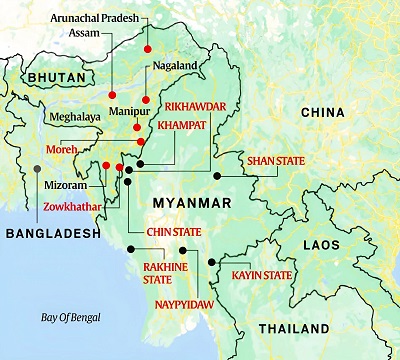Context
Recent media reports have highlighted India’s decision to invest US $3.7 billion in fencing its 1,610-kilometer-long border with Myanmar. This initiative follows the Indian government's revocation of the Free Regime Movement (FMR) agreement with Myanmar, which previously allowed people from both sides to cross the border up to 16 kilometers without a visa. This cessation, along with the establishment of strict military checkpoints, is seen as a necessary move to address the ongoing challenges in India’s North East Region (NER), such as drug trafficking and the influx of Myanmar refugees. However, the decision to erect a fence along the Indo-Myanmar border is not without complications. The region's difficult terrain and the close ethnic ties among the border communities present significant challenges to the successful implementation of this initiative. Thus, it is crucial for New Delhi to consider the socio-economic and political complexities of the NER states before proceeding with this policy.
Why Border Fencing is Imperative
Since the 1970s, India’s North East Region has been significantly affected by drug trafficking, largely due to its proximity to the Golden Triangle—an area encompassing Northwestern Myanmar, Northern Laos, and Northwestern Thailand, known as one of the world’s largest drug trafficking hubs. The unfenced and porous nature of the Indo-Myanmar border has facilitated the easy flow of narcotics into India, severely impacting the socio-economic conditions of the NER. The problem has intensified with Myanmar emerging as the world’s top opium producer in 2023, with a marked increase in illicit crop cultivation. Official reports for the fiscal year 2022-23 revealed that contraband worth over INR 2,000 Cr (around US$267 million) was seized in NER states. Assam and Manipur have reported significant drug confiscations and arrests of traffickers, indicating the severe scale of the problem. The continuation of this trend into 2024 further underscores the urgent need for stringent measures, including border fencing, to curb the trafficking of drugs originating from Myanmar.
The influx of Myanmar refugees, particularly in the states of Mizoram and Manipur, adds another layer of complexity to the situation. The 2021 military coup in Myanmar led to a surge in refugees seeking safety in India’s NER. While Mizoram has been welcoming towards these refugees due to shared ethnic ties, the long-term sustainability of this hospitality is uncertain. Mizoram's primarily agrarian economy and its status as a landlocked and less developed state raise concerns about potential resource competition between local residents and the incoming refugees. The ongoing conflict between the Myanmar military and resistance groups is likely to further increase the number of refugees, making it imperative for India to implement strict measures along the border to manage immigration challenges.
What Are the Challenges?
The Indian government’s decision to revoke the FMR and propose border fencing has elicited varied responses from political leaders and entities in the NER. While the Chief Ministers of Assam, Arunachal Pradesh, and Manipur support the decision, citing the need to combat cross-border insurgency, illegal refugee infiltration, and drug trafficking, there is significant opposition from other regions. Nagaland, despite being under BJP rule, has opposed the move, and the Mizoram assembly passed a resolution against it. Furthermore, the National Socialist Council of Nagaland (Isak Muivah), a prominent Naga insurgent group currently under ceasefire with the Indian government, has expressed concerns that the fencing would disrupt the ethnic ties among Naga communities on both sides of the border. This highlights their aspiration for a unified Naga homeland, known as ‘Nagalim,’ which includes territories in both India and Myanmar.
Several tribal organizations from Manipur, Mizoram, and Nagaland have also voiced strong opposition to the Central government’s decision, rejecting the colonial-era border demarcation. They argue that the fencing could exacerbate regionalist aspirations and strain their relationship with the Indian state, potentially distancing them further from India. The presence of significant tribal populations along the Indo-Myanmar border underscores the interconnectedness of these communities. This demographic reality suggests that border fencing and the cancellation of the FMR could be a major grievance for the people on both sides, potentially disrupting the existing people-to-people connections.
The Central government’s decision also poses challenges to India’s broader geopolitical ambitions, particularly its Act East Policy aimed at strengthening ties with Southeast Asian countries. The geographical complexities of the Indo-Myanmar border, which includes low mountains in the south and rugged ridges and peaks in the north, present formidable challenges to implementing border initiatives. Past efforts to fence the border have been largely inefficient; for example, it took a decade to complete just 10 kilometers of fencing along the Manipur-Myanmar border. These logistical difficulties further complicate New Delhi's initiatives, making it essential to adopt a more nuanced approach.
Conclusion
India's decision to strengthen its border with Myanmar through fencing and the cancellation of the FMR presents a multifaceted scenario with potential negative consequences. While the porous border has undeniably facilitated illegal activities that undermine the socio-economic stability of the NER, the complex topography and close ethnic ties among the border communities complicate the effective implementation of this decision. The opposition from key political figures, insurgent groups, and local communities in the NER can further exacerbate existing tensions, potentially heightening regionalist aspirations and hindering New Delhi’s Act East Policy. To address these challenges, India’s border strategy with Myanmar requires a balanced approach that considers both security concerns and the intricate realities of the region.
|
Probable Questions for UPSC Mains Exam
|
Source – The Indians Express







